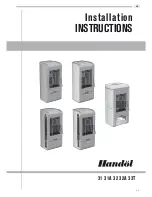
220206-20
SUPER-SD1
3
PLEASE SAVE THESE INSTRUCTIONS
NOTE: WE STRONGLY RECOMMEND THAT SMOKE DETECTORS BE INSTALLED.
If smoke detectors have been previously installed, you may notice that they are operating more frequently. This may be due to curing
of stove paint or fumes caused by accidentally leaving the fire door open. Do not disconnect the detectors. If necessary, relocate
them to reduce their sensitivity.
SAFETY NOTICE: If this stove is not properly installed, a house fire may result. For your safety, follow the installation
instructions. Contact local building or fire officials about restrictions and installation inspection requirements in you area.
Please read this entire manual before you install and use your new room heater. Failure to follow instructions may result in property
damage, bodily injury, or even death.
Safety and Maintenance
1. Burn wood only, dry and well seasoned. The denser or
heavier the wood when dry, the greater its heat value. This
is why hardwoods are generally preferred. Green or wet
wood will cause a rapid buildup of creosote. If you feel it
is necessary to burn wet or unseasoned wood, do so only
with the air inlet set open enough to maintain a good strong
fire and fairly high chimney temperatures. Do not attempt
to burn overnight using green wood or wet wood. Wet
wood can cause up to 25% drop in heater output, as well as
contributing significantly to creosote buildup.
WARNING: Never use chemicals or any other volatile
liquid to start a fire. Do not burn garbage, or flamma-
ble fluids such as gasoline, naptha, or engine oil. We
strongly recommend that smoke detectors be installed.
2. Remove ashes frequently. Embers can roll out the door and
create a fire hazard. Maintain a 1" minimum ash base.
3. If glass becomes darkened through slow burning or poor
wood, it can readily be cleaned with fireplace glass cleaner
when stove is cold. Never scrape with an object that might
scratch the glass. The type and amount of deposit on the
glass is a good indication of the flue pipe and chimney
buildup. A light brown dusty deposit that is easily wiped
off usually indicates good combustion and dry, well-sea-
soned wood and therefore relatively clean pipes and chim-
ney. On the other hand, a black greasy deposit that is
difficult to remove is a result of wet and green wood and too
slow a burning rate. This heavy deposit is building up at
least as quickly in the chimney.
WARNING: ONLY USE MATERIALS SUPPLIED
BY MANUFACTURER WHEN DOING MAINTE-
NANCE OR REPLACEMENTS.
4. DOOR GASKETS - The gasket used by Pacific Energy
(7/8" medium density fiberglass rope) requires only light
pressure to seal. This will prolong seal life. It is important
that the door seal be maintained in good condition. Periodi-
cally inspect seals and replace if necessary. Follow instruc-
tions included in the DR31.WDGKIT kit obtainable from
your nearest Pacific Energy dealer.
5. DOOR GLASS - Do not slam loading door or otherwise
impact glass. When closing door, make sure that no logs
protrude to impact the glass. If the glass gets cracked or
broken,
it must be replaced before using the stove.
Replacement glass can be obtained from your dealer. Use
8-13/16" x 15-1/4" x 5 mm. Ceramic glass only.
Do not
substitute with any other type.
To remove broken glass, undo the four retaining screws and
remove clamps and frame, noting position for re-assembly.
Remove all particles of glass . Be careful as they are very sharp.
Install new glass complete with gasket. Replace frame, clamps
and screws.
CAUTION:
- do not overtighten, tighten screws very carefully
- do not clean glass when hot
- do not use abrasive cleaners on glass
6. The area where boost combustion air enters the firebox
must be kept clear of excessive ash buildup which will
block air flow. This area is at the front of the firebox.
7. Do not store wood within heater installation clearances, or
within the space required for fuel loading and ash removal.
Keep the area around the heater clean and free of loose
combustibles, furniture, newspapers, etc.
8. If gold door requires cleaning, use mild soap and water
only.
Use of abrasive cleaners will void warranty.
9. Establish a routine for the fuel, woodburning and firing
technique. Check daily for creosote buildup until experi-
ence shows how often you need to clean to be safe.
10. Be aware that the hotter the fire, the less creosote is
deposited. Weekly cleaning may be necessary in mild
weather, even though monthly cleaning is usually enough
in the coldest months when burning rates are higher.
11. Instruct all members of your family on the safe operation of
the heater. Ensure they have enough knowledge of the
entire system if they are expected to operate it. Stress the
section on chimney fires and the importance of following
the steps outlined "In Case of Chimney Fire".




































